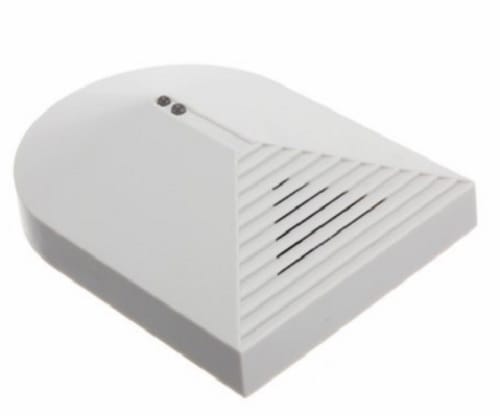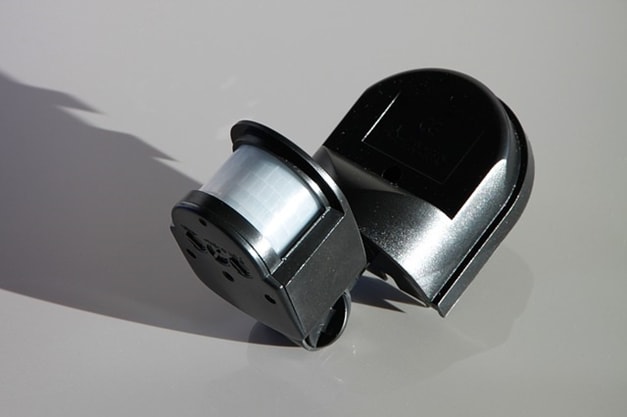What is a Glass Break Sensor?
A glass break sensor is a sensor that detects the vibrations in the glass surface it is connected to. The device will trigger an alarm in case an intruder breaks the glass and consequently tries to enter your facility. This solution is extremely widespread for businesses and it can be used as part of a broader security ecosystem that connects intrusion detection sensors, security cameras and access control.
In the next paragraphs, we will dive into how these sensors work, how to purchase the best solution for your needs, and what are the best glass break sensor manufacturers.
How Does a Glass Break Sensor Work?
A glass break sensor provides an additional layer of security by monitoring sound and/or vibrations on a glass surface. These devices are being activated by shock waves or sounds originating from glass being shattered.
The main concept is that a narrow microphone, installed in the device, detects either the sound breaking a certain noise threshold (that, in the more modern solutions, can be customized by the customer) or recognizes a sound pattern typically associated with a glass breaking.
Even if this functioning might seem easy, it really relies on very advanced technology to filter out all the noises that are not related to a glass breaking.
Nowadays, glass break detectors come in both hardwired and wireless forms. Choose wisely if you prefer the tranquility of a hardwired solution or the easy setup of a wireless detector. Wireless detectors are easier to install and more esthetically pleasing as they do not require cables hanging around in your home/company.
Hardwired glass break detectors, however, are a bit more reliable (as less subject to interference) and do not require maintenance like the wireless ones (that rely on batteries that need to be changed periodically).

Glass Break Detectors vs Motion Sensors
Motion sensors and glass break sensors are both pieces of hardware that enhance your security. They can be used at the same time and work together to create an additional layer of safety. The differences between the two are pretty huge as the motion sensors work with ultrasonic, microwave, or infrared radiations whereas the glass break sensors, as we've just seen, work with acoustic waves.
This means that motion sensors detect interference in the physical composition of a room whereas glass break sensors detect interferences in the audio waves.
Another difference is that you can leave your glass break detectors armed all the time, which is not the case with motion sensors. Obviously, you will need to switch off motion sensors while at home or at the office. This way, the chance is you might occasionally fail to activate the motion detectors, leaving your property unprotected.

You get enhanced security using both motion sensors and glass break sensors. Security experts suggest using motion sensors before glass break detectors and securing locations that are hard to secure using a glass break sensor. Those may include your rooftop or windowless basement. In both cases, an intruder can make a hole to penetrate your property. These are not common methods to break into the average home but are options you should consider.
If you want to know more about motion sensors, do not hesitate to check out our motion sensor alarms guide.
How to Choose Your Glass Break Sensors
Choosing a glass break sensor can be intimidating if you are not an IT or security expert. For this reason, we have collected some of the features that are generally recommended for good glass break sensors. Let's see what these features are.
- A high-quality narrowband microphone that reduces the chances of a false alarm.
- As an alternative, broadband microphones that analyze sound on more than one level, resulting in more accurate monitoring.
- If the solution has a microprocessor paired with the microphone, this will analyze the frequency, intensity, and timing of intrusion sounds and will detect even “soft breaks” which might otherwise go undetected. This dual technology produces minimum false alarms and is more secure.
- A broad range glass break sensor that can protect glass up to 30 feet away.
- Mounting on ceilings reduces the chance of the signal being obstructed by furniture or other obstacles.
- Low energy consumption for extended sensor life.
- Indicators for sensor testing and low battery.
Why Install Glass Break Detectors
Glass break sensors really represent the ultimate level of security when it comes to the perimetral defense of your facility. In some cases, door and window sensors are enough to get a satisfying level of security but when it comes to doors and windows that are accessible to humans, it is best to protect them with glass break sensors.
Glass Break Sensors Manufacturers
Navigating in the wide offering of glass break sensors could be intimidating for the majority of the people even with the suggestions we have given above. Many customers ask for our opinion in terms of which are the best manufacturers and for this reason, we have created a separate article on the best glass break sensors for your business.
For those who only want a brief overview, let's go through the most searched for brands.
Glass Break Sensors Simplisafe
Simplisafe is often regarded as one of the best security companies on the market when it comes to intrusion detection hardware. Glass break sensors are definitely not an exception in this case. Simplisafe's glass break sensors offer great performance for a not-too-high price tag.
The glass break sensors work smoothly and are easy to install and connect to other platforms. The only complaints are regarding the battery usage that seems to be a bit faster than expected. As the detectors are wireless, battery maintenance is needed and has to be performed every couple of years.
Apart from this small criticism, the solution works great and it will definitely upgrade your security setup.
Ring Glass Break Sensor
Many customers enjoy Ring and ask questions about their glass break sensors. The truth is that there are no real glass break sensors produced by the company and, although there are some ways to set up glass break alerts through Alexa, there are not many reviews that document the actual efficacy of this process.
In general, we would recommend businesses to rely on other brands for a lower risk of inconveniences.
Glass Break Sensor ADT
ADT is another example of a company that has been creating high-level security hardware for many years. Their glass break sensors are some of the best on the market and have the advantage of seamlessly integrating with all the ADT hardware you have in place, including their dashboard.
This lets you have immediate feedback in case your glasses are shattered. The downside of ADT is that having a fully connected ADT security system might come with a slightly higher price tag but this should not demoralize you if your company has higher security needs or a bigger office.
Glass Break Sensor Vivint
Vivint glass break detectors are often considered the best on the market. Their ease of use and installation combined with their great looks makes it a very easy choice for many privates and businesses. Their sensors are also easy to combine with other solutions and can help you create a great security system.
The only downside to this solution is the quality of the materials that, despite the great looks, keeps some customers from purchasing them. Vivint is also a wireless solution, like many we've seen above, and this makes for an overall more annoying device to maintain than a hardwired solution.
Honeywell Glass Break Sensor
Honeywell's sensors are similar to other options as the company is well-established for high-quality security systems. Their glass break sensors are easy to install and integrate with other solutions.
Like the other companies, they share the downside of being a wireless solution and, for this reason, being more subject to maintenance. Another complaint is the price tag that is slightly above the average and their short-range sensor (only 15ft compared to the 25ft of the other solutions).
For more information about glass break sensors, visit our guide on the best glass break sensors for your business
Glass Break Sensors and Access Control
When one thinks of access control and glass break detectors, the link between the two is often blurry and for a reason. As a matter of fact, the functioning of the two is not at all interdependent. This is true unless we are talking about the two systems in the context of a bigger security system. Some very advanced access control systems, in fact, offer the possibility of natively managing external intrusion detection devices, such as glass break sensors, from the same dashboard.
Kisi, for example, uses its feature Intrusion Detection to make sure that glass break detection is properly managed from its cloud dashboard making security incredibly easy and intuitive to manage for admins or property owners. If you are interested in learning more about our feature check out our product page or contact our sales team.
If, instead, you want to learn more about intrusion alarms, check out our overview page.